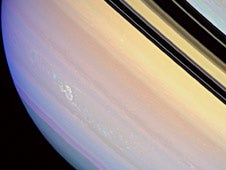As a powerful electrical storm rages on Saturn with lightning bolts 10,000 times more powerful than lightning on Earth, the Cassini spacecraft continues its 5-month watch over the dramatic events.
Scientists with NASA’s Cassini-Huygens mission have been tracking the visibly bright, lightning-generating storm — the longest continually observed electrical storm ever monitored by Cassini.
Saturn’s electrical storms resemble terrestrial thunderstorms, but on a much larger scale. Storms on Saturn have diameters of thousands of miles (several thousand kilometers) and radio signals produced by their lightning are thousands of times more powerful than those produced by terrestrial thunderstorms.
Lightning flashes within the persistent storm produce radio waves called Saturn electrostatic discharges, which the radio and plasma wave science instrument first detected on November 27, 2007. Cassini’s imaging cameras monitored the position and appearance of the storm, first spotting it about a week later, on December 6.
“The electrostatic radio outbursts have waxed and waned in intensity for five months now,” says Georg Fischer, an associate with the radio and plasma wave science team at the University of Iowa, Iowa City. “We saw similar storms in 2004 and 2006 that each lasted for nearly a month, but this storm is longer-lived by far. And it appeared after nearly two years during which we did not detect any electrical storm activity from Saturn.”
The new storm is located in Saturn’s southern hemisphere — in a region nicknamed “Storm Alley” by mission scientists — where the previous lightning storms were observed by Cassini.
“In order to see the storm, the imaging cameras have to be looking at the right place at the right time, and whenever our cameras see the storm, the radio outbursts are there,” says Ulyana Dyudina, an associate of the Cassini imaging team at the California Institute of Technology in Pasadena.
Cassini’s radio plasma wave instrument detects the storm every time it rotates into view, which happens every 10 hours and 40 minutes, the approximate length of a Saturn day. Every few seconds the storm gives off a radio pulse lasting for about a tenth of a second, which is typical of lightning bolts and other electrical discharges. These radio waves are detected even when the storm is over the horizon as viewed from Cassini, a result of the bending of radio waves by the planet’s atmosphere.
Amateur astronomers have kept track of the storm over its 5-month lifetime. “Since Cassini’s camera cannot track the storm every day, the amateur data are invaluable,” says Fischer. “I am in continuous contact with astronomers from around the world, the key players being Marc Delcroix and other observers from the French Astronomical Society, Ralf Vandebergh from the Netherlands, Christopher Go from the Philippines and Trevor Barry from Australia.”
The long-lived storm will likely provide information on the processes powering Saturn’s intense lightning activity. Cassini scientists will continue to monitor Storm Alley as the seasons change, bringing the onset of autumn to the planet’s southern hemisphere.










